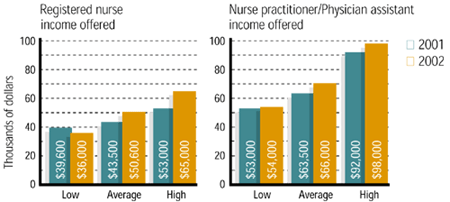
Fam Pract Manag. 2003;10(7):31-32
Physicians lobby to stop more Medicare payment cuts
Eighty health care organizations, including the AAFP and the AMA, recently joined together to ask Congress to include a fix for the Medicare physician reimbursement formula in any Medicare bills considered this year. Without such action, Medicare payment rates for physicians could fall 4.2 percent in 2004, with additional reductions in 2005, 2006 and 2007.
Earlier this year, Congress averted a 4.4-percent cut in physicians’ 2003 Medicare payments, a move that was expected to result in a positive physician payment update for 2004. However, revised projections from the Centers for Medicare & Medicaid Services now anticipate a 4.2-percent drop for 2004 due to the “sustainable growth rate” (SGR) expenditure target, which governs annual reimbursement updates for physicians and other practitioners. Due to the SGR, if the cost of services to beneficiaries grows faster than the gross domestic product, Medicare payments to physicians and other practitioners are cut.
“The formula penalizes physicians and other practitioners for volume increases that they cannot control and that the government actively promotes through new coverage decisions, quality improvement activities and other initiatives that, while beneficial to patients, are not reflected in the SGR,” wrote the organizations in a joint letter to Congress.
The Medicare Payment Advisory Committee, a group that advises Congress on Medicare issues, has recommended that the SGR formula be replaced with a more equitable formula and that physicians’ Medicare payments for 2004 be increased 2.5 percent.
At press time, both chambers of Congress were debating Medicare reform bills, including prescription-drug coverage proposals. Only the House had added an amendment to address the Medicare reimbursement formula.
Clinical support staff salaries
What does it take to hire a nurse these days? On average, it takes 16 percent more money than it took one year ago, according to Allied Consulting, a national recruitment firm. For nurse practitioners/physician assistants, average salaries have risen just 4 percent over the last year.

Solutions proposed to ease malpractice insurance crisis
Rising malpractice insurance premiums remain a source of concern for physicians across the country, and lawmakers are working on a variety of measures to address the crisis. In March, the House passed bill H.R. 5, which would cap noneconomic damages, such as pain and suffering, at $250,000. The Senate has not yet agreed on a bill. Twenty state legislatures are considering medical malpractice legislation, and at least 11 states have already passed such bills this year, reports the May 28 New York Times.
To provide short-term relief, Sen. Dick Durbin (D-Ill.) has proposed legislation that would award tax credits in 2003 and 2004 to doctors and hospitals to help pay for medical malpractice insurance. Under the proposal, physicians in high-risk specialties such as obstetrics, surgery, trauma care and neurology would be eligible for a tax credit of 20 percent of their total malpractice premiums. Other physicians would be eligible for a 10-percent tax credit. Proponents of the bill say it would provide needed relief as physicians wait for true reforms to take effect. Critics say the bill would force taxpayers to bear the burden of high malpractice premiums.
Meanwhile, the Common Good, a bipartisan legal reform coalition, is calling for more radical solutions to the malpractice insurance problem. The group has proposed the creation of a special medical court to help deal with medical malpractice suits, similar to the nation’s separate courts for patents or other specialized problems. The group also wants to enact reforms that would increase the incentive to settle malpractice cases and set limits on how much lawyers could collect (e.g., a cap of 10 percent of the first $100,000 of the settlement and 5 percent thereafter). The group is filing legal petitions for the reforms in 12 states.
PRACTICE PEARLS from here and there
Encourage patients to ask three questions
To combat the problem of health illiteracy and improve communication with your patients, encourage them to ask three simple but essential questions at every visit:
What is my main problem?
What do I need to do?
Why is it important for me to do this?
When answering these questions, you can improve your patient’s understanding if you do the following:
Use plain language instead of technical language or medical jargon.
Sit down (instead of standing) so you’ll be at eye level with your patient.
Use visual models to illustrate the procedure or condition.
Ask the patient to restate the care instructions you gave to him or her.
– The Partnership for Clear Health Communication’s “Ask Me 3” initiative. Available online at: www.askme3.org.
Thirty ways to be safe
The National Quality Forum (NQF), composed of representatives from the nation’s top health care and consumer groups, has endorsed 30 “evidence-based” patient-safety practices in its report Safe Practices for Better Healthcare. Among the recommended practices are the following: Prepare patient care summaries or other records from the original source documents, not from memory; use only standardized abbreviations and dose designations; require that verbal orders be repeated to the prescriber to verify the accuracy of what was heard; and ask patients to recount what they have been told during the informed consent discussion. For more information, visit www.qualityforum.org.
What would you do with $142?
Aetna Inc. has agreed to pay 700,000 U.S. physicians approximately $100 million, or $142 per physician, to settle its part of a class-action lawsuit against several large health insurers that allegedly delayed or discounted reimbursement for services and denied claims for medically necessary treatments as part of a racketeering conspiracy. Other insurers named in the lawsuit include Anthem BlueCross BlueShield, UnitedHealthcare, Cigna and Humana, all of whom are expected to settle as well.
Health care on the Net

Using the Internet to access health care information or to e-mail a physician is “not as common as is sometimes reported,” according to a study in the May 14 Journal of the American Medical Association. Researchers found that approximately 40 percent of respondents with Internet access searched the Web for health care information or advice in 2001, but only 6 percent used e-mail to contact a physician or other health care professional. Although few respondents reported e-mail communication with a physician, about 25 percent did use e-mail to discuss health issues with family or friends.
Would you like paper or plastic?
In a recent Harris Interactive Poll ranking how well 15 industries serve their customers, hospitals came in third, behind supermarkets and packaged food companies. Seventy-three percent of consumers surveyed said hospitals did a “good job” of meeting their needs, compared with 85 percent for supermarkets and 75 percent for packaged food companies. Pharmaceutical companies and health insurance companies were close to the bottom of the list, ranking eleventh and thirteenth, respectively.
Public favors award caps
More than 70 percent of Americans favor capping patients’ awards for emotional pain and suffering in order to curb the malpractice insurance crisis, according to a recent poll by the Kaiser Family Foundation. Over 60 percent favor limiting awards that punish doctors for their negligence. Although a 2002 poll showed the majority of the public viewed malpractice lawsuits as somewhat effective for reducing preventable medical errors, 57 percent now indicate patients are suing doctors too often.
Patients can help reduce Rx errors
A new guide developed by the Agency for Healthcare Research and Quality helps patients do their part in reducing prescription errors. The 12-page brochure, Your Medicine: Play It Safe, advises patients to get the facts about the medications they’re taking, stick with the treatment plan prescribed and keep a record of all medicines being taken. The guide includes a Medicine Record Form for patients to track the medications they’re taking. For more information, visit www.ahrq.gov/consumer/safemeds/safemeds.htm.
If they had it to do over again…
Nearly a quarter of newly trained non-primary-care-physicians surveyed say they would choose a field other than medicine if they had their education to do over again, according to Merritt, Hawkins & Associates’ 2003 Survey of Final-Year Medical Residents. In 2001, the same survey, which then included some primary care physicians, found that only 5 percent of physicians would choose a different field. Authors of the survey attribute the attitude change to increasing concerns about malpractice, dealing with managed care and other payers, and availability of free time.